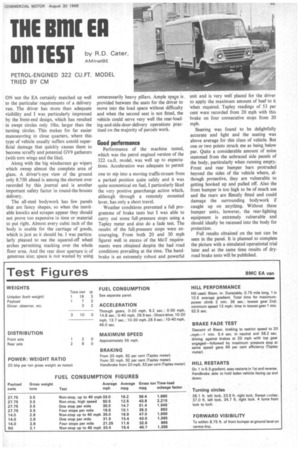THE BM EA UN TEST
Page 51

If you've noticed an error in this article please click here to report it so we can fix it.
by R.D. Cater, PETROL-ENGINED 322 CU.FT. MODEL TRIED BY CM
ON test the EA certainly matched up well to the particular requirements of a delivery van. The driver has more than adequate visibility and I was particularly impressed by the front-end design, which has resulted • in swept circles only 10in, larger than the turning circles. This makes for far easier manoeuvring in close quarters, where this type of vehicle usually suffers untold superficial damage that quickly causes them to become scruffy and potential GV9 gatherers (with torn wings and the like).
Along with the big windscreen go wipers which sweep almost the complete area of glass. A driver's-eye view of the ground only 8.75ft ahead is among the shortest ever recorded by this journal and is another important safety factor in round-the-houses delivery.
The all-steel bodywork has few panels that are fancy shapes, so when the inevitable knocks and scrapes appear they should not prove too expensive in time or material to put right. Almost every cubic inch of the body is usable for the carriage of goods, which is just as it should be. I was particularly pleased to see the squared-off wheel arches permitting stacking over the whole floor area. And the rear door aperture is of generous size: space is not wasted by using
unnecessarily heavy pillars. Ample space is provided between the seats for the driver to move into the load space without difficulty and when the second seat is not fitted, the vehicle could serve very well the rear-loading-and-side-door-delivery operations practised on the majority of parcels work.
Good performance
Performance of the machine tested, which was the petrol engined version of the 322 cu.ft. model, was well up to expectations. Acceleration was adequate to permit one to nip into a moving traffic stream from a parked position quite safely and it was quite economical on fuel. I particularly liked the very positive gearchange action which, although through a remotely mounted lever, has only a short travel.
Weather conditions prevented a full programme of brake tests but I was able to carry out some full-pressure stops using a Tapley meter and also do a fade test. The results of the full-pressure stops were encouraging. From both 20 and 30 mph figures well in excess of the MoT requirements were obtained despite the bad road conditions prevailing at the time. The handbrake is an extremely robust and powerful
unit and is very well placed for the driver to apply the maximum amount of beef to it when required. Tapley readings of 53 per cent were recorded from 20 mph with this brake on four consecutive Stops from 20 mph.
Steering was found to be delightfully accurate and light and the seating was above average for this class of vehicle. But one or two points struck me as being below par. Quite a considerable amount of noise stemmed from the unbraced side panels of the body, particularly when running empty. Front and rear bumper bars protruded beyond the sides of the vehicle where, although protective, they are vulnerable to getting hooked up and pulled off. Also the front bumper is too high to be of much use and the rears are flimsily fitted and could damage the surrounding bodywork if caught up on anything. Without these bumper units, however, the rear-lighting equipment is extremely vulnerable and should ideally be recessed into the body for protection.
Full results obtained on the test can be seen in the panel. It is planned to complete the picture with a simulated operational trial later and at the same time results of dryroad brake tests will be published.




















































































